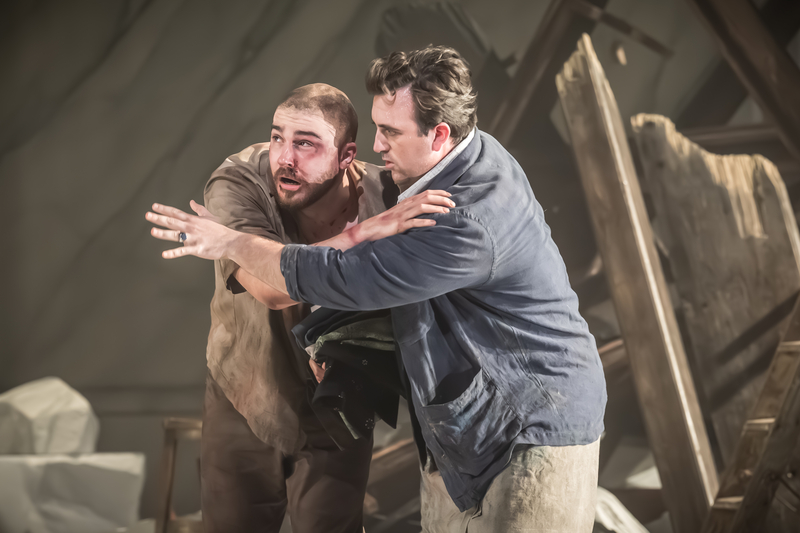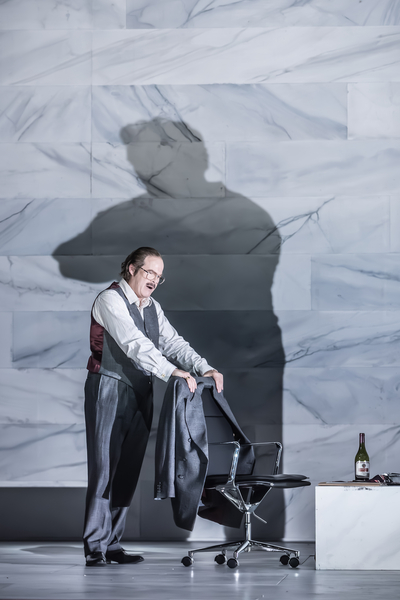Tosca, Royal Opera review - Ailyn Pérez steps in as the most vivid of divas | reviews, news & interviews
Tosca, Royal Opera review - Ailyn Pérez steps in as the most vivid of divas
Tosca, Royal Opera review - Ailyn Pérez steps in as the most vivid of divas
Jakub Hrůša’s multicoloured Puccini last night found a soprano to match

Forget Anna Netrebko, if you ever gave the Russian Scarpia’s former cultural ambassador much thought (theartsdesk wouldn’t). It should be uphill from now on as Aleksandra Kurzak takes over the role of a diva out of her depth. Last night, though, she was unwell, and the role was taken by Ailyn Pérez, a lyric soprano who knows how to pull out all the right stops and whose dramatic truth complemented Oliver Mears’ production to perfection, presumably on little rehearsal time.
Mears plays mostly by the Puccini/Giacosa/Illica rulebook of love and terror in totalitarian Rome - foolish the director who would throw the musically and dramatically perfect guidelines aside – with an extra twist of contemporary violence in the second and third acts which is apt, if unsettling (when were torture and execution ever comfortable viewing?)
I didn’t quite see the results of set designer Simon Lima Holdsworth’s promise to go for the look of Rome’s wacky Sant’Ivo alla Sapienza in Act One rather than the original Roman setting, Sant’Andrea delle Valle, and the castle cannon transformed into bombing, complete with lighting flashes, as police chief Scarpia sets his plans in motion during the “Te Deum” at the end of the act didn’t really add anything. But the massive marble wall and gold door for his clinically clean office in Act Two and the queasy, striplit execution chamber of Act Three make this a Tosca with a difference. Clocks respectively big and small tell us that one murder, rather than the intended rape of the diva, will take place at midnight and the other, as originally planned, at 4am (we know how it’s going to happen from a third killing in the Act Three prelude).  Hrůša, miraculously alert to every phrase and colour in a score as great in its way as that of any Wagner masterpiece, goes relatively easy on the first act. We need to love and laugh at the vibrant, easily sensual relationship between Tosca and her painter-come-freedom fighter Cavaradossi, even at her jealousy which Scarpia so skilfully manipulates to track his political prey. Though Freddie De Tommaso (pictured above by Marc Brenner on the right with Jette Parker Artis Ossian Huskinson as escapee Angelotti) tarted loud in his comparison of two beauties, you knew he’d be up to the big dramatic charges when they came – he even toned it down for a fine “E lucevan le stelle” - and he’s a plausible enough actor.
Hrůša, miraculously alert to every phrase and colour in a score as great in its way as that of any Wagner masterpiece, goes relatively easy on the first act. We need to love and laugh at the vibrant, easily sensual relationship between Tosca and her painter-come-freedom fighter Cavaradossi, even at her jealousy which Scarpia so skilfully manipulates to track his political prey. Though Freddie De Tommaso (pictured above by Marc Brenner on the right with Jette Parker Artis Ossian Huskinson as escapee Angelotti) tarted loud in his comparison of two beauties, you knew he’d be up to the big dramatic charges when they came – he even toned it down for a fine “E lucevan le stelle” - and he’s a plausible enough actor.
Pérez’s Floria Tosca is a hypersensitive but at first still likeable lover, credibly youthful as was Angela Gheorghiu when the previous production by Jonathan Kent first opened at the Royal Opera, but capable of going further than her in bite. Every top note hits the mark, subtle phrasing lines the characterisation, and all her reactions to the horrors that suddenly unfold in Act Two are credible, not histrionic. This was a “Vissi d’arte” which started with such refined, luminous emotion that it brought tears to the eyes. And in Act Three, we simply see the diva as a vulnerable girl who’s placed her trust in a lie – fake execution and safe conduct out of Italy – which Cavaradossi doesn’t believe for a moment. The touch of her theatrical bolt-upright when she tells him to act it nobly still brough a laugh from an audience hungry for humour throughout.
 Having seen Gerald Finley not succeed many years ago as a treacherous seducer in Glyndebourne’s Don Giovanni, I was surprised at the all-round success of his Scarpia (pictured left by Marc Brenner). At first Hrůša matches his suavity and skill with an equally light touch, but the dark colourings which underpin the monster at the start of the next act fully complemented the murderous bureaucrat who wheels around on his office chair.
Having seen Gerald Finley not succeed many years ago as a treacherous seducer in Glyndebourne’s Don Giovanni, I was surprised at the all-round success of his Scarpia (pictured left by Marc Brenner). At first Hrůša matches his suavity and skill with an equally light touch, but the dark colourings which underpin the monster at the start of the next act fully complemented the murderous bureaucrat who wheels around on his office chair.
All the turns of the screw in the murderous thriller which unfolds are infallibly done, and it’s only at the curtain call that you properly register how this is an opera about a woman completely alone in a sea of officials and fugitives, with not even a female confidante to support her. In short, everything works. Curious to think that the Tosca the Royal Opera should have engaged for opening night, Welsh-Ukrainian soprano Natalya Romaniw, was singing the role in Wales - Stephen Walsh gave her the highest praise here - at exactly the same time.
The future of Arts Journalism
You can stop theartsdesk.com closing!
We urgently need financing to survive. Our fundraising drive has thus far raised £49,000 but we need to reach £100,000 or we will be forced to close. Please contribute here: https://gofund.me/c3f6033d
And if you can forward this information to anyone who might assist, we’d be grateful.

Subscribe to theartsdesk.com
Thank you for continuing to read our work on theartsdesk.com. For unlimited access to every article in its entirety, including our archive of more than 15,000 pieces, we're asking for £5 per month or £40 per year. We feel it's a very good deal, and hope you do too.
To take a subscription now simply click here.
And if you're looking for that extra gift for a friend or family member, why not treat them to a theartsdesk.com gift subscription?
more Opera
 Tosca, Royal Opera review - Ailyn Pérez steps in as the most vivid of divas
Jakub Hrůša’s multicoloured Puccini last night found a soprano to match
Tosca, Royal Opera review - Ailyn Pérez steps in as the most vivid of divas
Jakub Hrůša’s multicoloured Puccini last night found a soprano to match
 Tosca, Welsh National Opera review - a great company reduced to brilliance
The old warhorse made special by the basics
Tosca, Welsh National Opera review - a great company reduced to brilliance
The old warhorse made special by the basics
 BBC Proms: The Marriage of Figaro, Glyndebourne Festival review - merriment and menace
Strong Proms transfer for a robust and affecting show
BBC Proms: The Marriage of Figaro, Glyndebourne Festival review - merriment and menace
Strong Proms transfer for a robust and affecting show
 BBC Proms: Suor Angelica, LSO, Pappano review - earthly passion, heavenly grief
A Sister to remember blesses Puccini's convent tragedy
BBC Proms: Suor Angelica, LSO, Pappano review - earthly passion, heavenly grief
A Sister to remember blesses Puccini's convent tragedy
 Orpheus and Eurydice, Opera Queensland/SCO, Edinburgh International Festival 2025 review - dazzling, but distracting
Eye-popping acrobatics don’t always assist in Gluck’s quest for operatic truth
Orpheus and Eurydice, Opera Queensland/SCO, Edinburgh International Festival 2025 review - dazzling, but distracting
Eye-popping acrobatics don’t always assist in Gluck’s quest for operatic truth
 MARS, Irish National Opera review - silly space oddity with fun stretches
Cast, orchestra and production give Jennifer Walshe’s bold collage their all
MARS, Irish National Opera review - silly space oddity with fun stretches
Cast, orchestra and production give Jennifer Walshe’s bold collage their all
 Káťa Kabanová, Glyndebourne review - emotional concentration in a salle modulable
Janáček superbly done through or in spite of the symbolism
Káťa Kabanová, Glyndebourne review - emotional concentration in a salle modulable
Janáček superbly done through or in spite of the symbolism
 Buxton International Festival 2025 review - a lavish offering of smaller-scale work
Allison Cook stands out in a fascinating integrated double bill of Bernstein and Poulenc
Buxton International Festival 2025 review - a lavish offering of smaller-scale work
Allison Cook stands out in a fascinating integrated double bill of Bernstein and Poulenc
 Tosca, Clonter Opera review - beauty and integrity in miniature
Happy surprises and a convincing interpretation of Puccini for today
Tosca, Clonter Opera review - beauty and integrity in miniature
Happy surprises and a convincing interpretation of Puccini for today
 Hamlet, Buxton International Festival review - how to re-imagine re-imagined Shakespeare
Music comes first in very 19th century, very Romantic, very French operatic creation
Hamlet, Buxton International Festival review - how to re-imagine re-imagined Shakespeare
Music comes first in very 19th century, very Romantic, very French operatic creation
 Falstaff, Glyndebourne review - knockabout and nostalgia in postwar Windsor
A fat knight to remember, and snappy stagecraft, overcome some tedious waits
Falstaff, Glyndebourne review - knockabout and nostalgia in postwar Windsor
A fat knight to remember, and snappy stagecraft, overcome some tedious waits
 Salome, LSO, Pappano, Barbican review - a partnership in a million
Asmik Grigorian is vocal perfection in league with a great conductor and orchestra
Salome, LSO, Pappano, Barbican review - a partnership in a million
Asmik Grigorian is vocal perfection in league with a great conductor and orchestra

Add comment